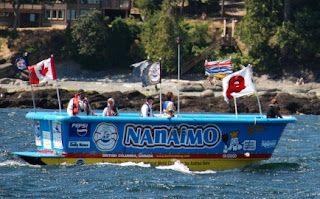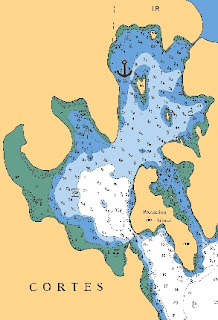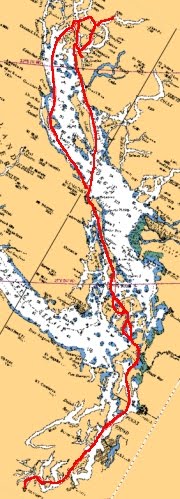Whenever planning a trip "upcoast" you need to carefully consider crossing "
the Monster." Walt Woodward in his excellent little book - "
How To Cruise to Alaska Without Rocking The Boat" devoted nearly a whole chapter to crossing the Strait of Georgia, which he called the Monster. After 21 years of experience, I have nothing but respect for this leg of the upcoast journey. A rough crossing can affect the whole rest of the trip.

What makes this body of water so feared or respected? Mostly it has to do with the geography. It's a large inland sea trapped between two mountain ranges - the mountains on Vancouver Island and the Coast Range on the mainlaind. These mountains form a venturi, or funnel for the wind that either comes from the NW or SE. Since the summer Pacific High forms in the Gulf of Alaska, I worry more about NW winds although you do get the occasional storm that will bring SE winds. These "
moderate northwesterlies" can blow relentlessly for days on end. My observation is that the winds are always worse on the Vancouver Island side than the mainland side.
The winds are commonly worst in the early morning, dying down around mid-day, and then again picking up late in the evening or at night. So keep that in mind. The best tool for planning to cross the Strait is listening to the Canadian Weather Radio on VHF WX1 - Comox Coast Guard Radio. It is updated daily at 4 AM, 10:30 AM, 4 PM, and 10 PM, although the spot observations are updated hourly. I carefully listen to the weather observations for the following places:
- Entrance Island - E of Nanaimo
- Ballenas Island - W of Nanaimo
- Sisters Island - W of Nanaimo, and mid-Georgia Strait
- Merry Island - N of Nanaimo, and on the mainland side
- Cape Lazo - Vancouver Island side
- Grief Point - Near Powell River, mainland side
The wind reports at Cape Lazo, Sisters Island and Ballenas Island will give you the best picture of crossing the Strait. If the wind is blowing greater than 15 knots you're in for a rough ride - seas 3' or more. If they're blowing greater than 20 knots you're in for a terrible ride - seas 4' or more. Ugh! Another complicating factor is if Area WG - "Whiskey Golf" is active. Area WG is the torpedo testing range and any entry into this area when active is strictly "verbotten." No exceptions. Again the Weather Radio will tell you if "Whiskey Golf" is active. If so, you've got to stay clear of it by traveling W to Ballenas Island (via Ballenas Channel) and then make your way N across the Strait. If a strong NW is blowing that will put you "beam to" the NW waves & swell for about 5-8 nautical miles. "Whiskey Golf" is generally not active on Sundays.
My route, depending on winds... if 15 knots or greater I stick close to the Vancouver Island shore out of Nanaimo and will duck in behind the Winchelsea Islands. If the winds are too strong and the seas too rough I'll stay at a great nearby marina - Schooner Cove - and wait for the winds to die down. If not, I will turn just E of Ballenas and make for E end of Lasqueti Island (towards Squitty Bay). That will put me in beam seas to the NW waves and swell for only about 5 nm. I'll then duck into one of the many anchorages in and around Bull Passage of Lasqueti and Jedediah Islands.
If the wind is less than 10 knots and Area WG is not active, I will make for either the E end of Lasqueti or Texada Island (Upwood Pt.) and then travel up Sabine Channel or Malaspina Strait. If I choose to do Sabine Channel, the forecast has to be for winds less than 10 knots because once you get past Lasqueti Island you're open to the full NW open waters of Georgia Strait. You'll save about 8 nm going this route to Desolation Sound. Otherwise I'll travel up Malaspina Strait - careful, once you round NW point on E side of Texada Island the NW winds and seas can be terrible. Again, plan accordingly.
What I really like to do is leave Nanaimo, make a direct route to Bull Passage of Lasqueti Island, anchor, and then finish crossing "
the Monster" for the next day. The whole time I am listening over and over again to the weather radio. This cruise plan breaks up the Georgia Strait crossing to 5 hours one day and about 9 hours the next day. And, there are so many places to enjoy and explore in and around Jedediah Island - its beautiful.
Finally, I always try to plan riding the flood when going up the Georgia Strait. There's not too much current but every little bit helps. Below is the tide chart for July 22 outside of Powell River. My plan here is to leave early from my anchorage in Bull Passage area and then ride the flood all the way to Squirrel Cove.












